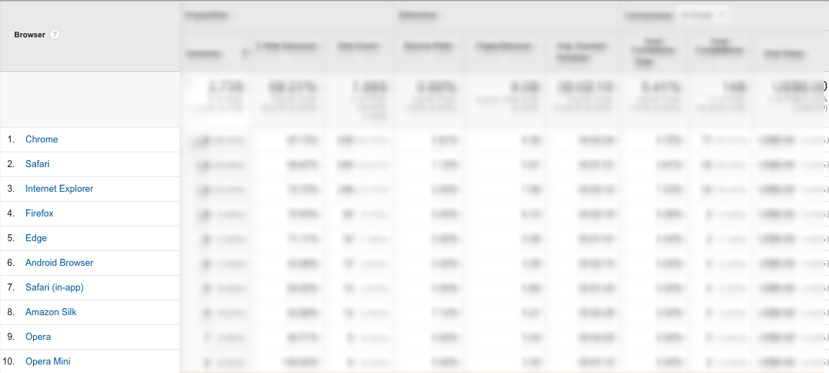Getting Started with Google Analytics
Getting Started with Google Analytics
Get weekly
HubSpot Updates
This blog post is a first of a series aimed at those preparing for their Google Analytics Fundamental exam, or even wanting to brush up on their knowledge in this minefield of a subject. So if you’re in need of some supplementary reading, this post is the one for you.
As a business in the 21st Century, it is all well and good being on various digital platforms to promote yourself. I’ve seen businesses utilise a diverse range of mediums and platforms, ranging from websites and apps to social media channels - which is great. However, as a self-proclaimed digital marketing geek, very few things are more annoying than not being able to track your marketing efforts. Where are your customers coming from? How well did your campaign perform? Or, God forbid, did it flop?
This is where digital analytics comes into play. It is the holy grail of online marketing, and in this article I shall discuss what digital analytics is, the importance of it, creating a measurement plan, core analysis techniques, conversions and conversion attributions and the role they all play in Google Analytics. Brace yourselves…
What is digital analytics?
According to Google’s very own Justin Cutroni, “Digital analytics is the analysis of qualitative and quantitative data from your business and the competition to drive a continual improvement of the online experiences that your customers and potential customers have which translates to your desired outcomes, both online and offline ”.
Now that we’ve established what digital analytics is, let's discuss its importance.
The Importance of digital analytics
With technology advancing as fast as it is and computer power increasing, the power has shifted over to the consumer. The consumer now has the upper hand and can access information as and when they wish to. So from a business perspective, it is logical to track the journey consumers take when buying from you in order to improve your online marketing efforts.
Therefore, an important digital analytics step is determining what your business objectives are and how you can measure them.
There are key actions on mobile application or websites that are linked to a business’ objectives. The activity indicates that an objective - such as a purchase on an ecommerce site - has been met. They are known as “macro” conversions.
On the other hand, some of the actions on a site might also be indicators that a customer hasn’t reached your main objectives yet, but is coming closer, like signing up for email coupons for an ecommerce site. These are known as “micro” conversions.
It is important for businesses to measure micro and macro conversions in order to understand what helps to achieve the overall business objective.
Creating a measurement plan
As your business objectives will influence what you track in Google Analytics, it is important to create a measurement plan. This way you’ll be able to track the data that you give the most priority to.
There are five steps to creating a measurement plan to track online performance:
- Start with your business objectives;
- Identify strategies to help achieve the desired business objectives;
- Choose your KPIs (Key Performance Indicators);
- Decide how to segment your target audience;
- Choose targets.
The Core Analysis Techniques
Core Analysis Techniques are relevant to digital analytics as they provide in-depth information to the data gathered by Google Analytics. Core Analysis Techniques include Segmentation and Context. Each of these techniques have their benefits and should not be disregarded. For example, segmentation looks at aggregated data, isolates it and allows you to analyse it in order to derive meaningful conclusions. Data in Google Analytics can be segmented by day, time and even device.

Additionally, context helps understand the performance and can be divided into external context, such as the business’ industry performance, and internal context, which can include historic business performance. This analytics data can be used to benchmark businesses and identify areas and ways to improve a business' digital marketing.
Conversions and Conversion Attributions
Remember when I mentioned “macro” and “micro” conversions earlier? Well, this section relates to them, as attribution is assigning credit for a conversion.
There are three types of attribution: the last-click attribution model, where all of the values associated with the conversion are assigned to the last marketing activity that generated the revenue; the first-click attribution model, where all of the values are assigned to the first channel - the one that started the user’s consumer journey; and finally the linear attribution model, which assigns all of the channels the same value.
It is important to understand attribution models because it can help you to digest digital analytics that much easier. Also, it can help with budgeting accordingly to each marketing channel.
Conclusion
That’s the end of the first chapter of the Google Analytics Fundamental course! Let me know what you thought of the subject in the comments below and if there’s any particular area you want me to delve into.
Keep your eyes peeled for the next blog post where I’ll be exploring the use and understanding of Google Analytics data. See you on the other side!
Our content includes affiliate links. This means that we may receive a commission if you make a purchase through one of the links on our website. This will be at no cost to you and helps to fund the content creation work on our website.